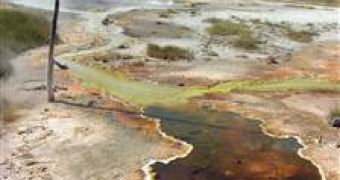From the most impressive geysers in the world to muddy volcanoes and thermal spring, Yellowstone National Park is a natural marvel. The park's life is spectacular, but the biggest surprises do not come from the grizzly bears and bisons, but from the bacteria inhabiting the hot springs.
Researchers have discovered an unusual bacterium species - called Chloracidobacterium thermophilum - that uses photosynthesis, and lives in the colorful mats of microbes drift in the warmth of a hot spring. "This thing was just bizarre," said David M. Ward, a professor of microbial studies at Montana State University.
Besides plants, many bacteria are known to make photosynthesis (to turn light into energy); even the plant structures that make photosynthesis are believed to be at their origin bacterial symbionts.
"But, the newly discovered type has a new kind of photosynthesis. It uses the same kind of machinery, but has the parts in a different arrangement. The find is going to be important for unraveling the history of photosynthesis, in determining how microbes efficiently harvest energy. We're running out of fossil fuel, so the more efficiently we can harvest light energy the better," Ward said.
"Finding a previously unknown, chlorophyll-producing microbe is the discovery of a lifetime. I wouldn't have been as excited if I had reached into that mat and pulled out a gold nugget the size of my fist!" said co-author Don Bryant, a professor of biotechnology at Penn State University.
Yellowstone's hot spring harbors many species of heat-loving bacteria, and their potential use in biotechnology or medicine has been investigated for years. "Indeed, these ponds have been studied for 40 to 50 years and yet they can still discover a completely new organism." said Ward.
The new bacterium lives in the same hot springs where the bacterium Thermus aquaticus had been discovered years ago. T. aquaticus helped in the development of the polymerase chain reaction, used for amplifying DNA material, now a routine procedure in genetic analyses. "There are other chlorophyl-producing microbes, but the new one - Cab. thermophilum - is a completely different type than the others that are known," said the researchers.
The bacterial mats give the hot springs in Yellowstone a variety of colors, from yellow, orange, red, brown to green. C. thermophilum thrives near the surface of the mats amongst other bacteria or blue-green algae, at a temperature varying from 122 to 151o F (50 to 66o C).
By now, it has been discovered in three hot springs: Mushroom Spring, Octopus Spring and Green Finger Pool in the Lower Geyser Basin. "The new bacterium has light-harvesting antennae known as chlorosomes, which contain about 250,000 chlorophylls each. It is the first aerobic microbe known to make chlorosomes.", Ward said.
C.thermophilum has two types of chlorophyll that allow it to thrive in microbial mats and to stand competition for light energy with the other microbes. DNA analysis showed that their closest relatives live around Mammoth Hot Springs in Yellowstone and hot springs in Tibet and Thailand.

 14 DAY TRIAL //
14 DAY TRIAL //